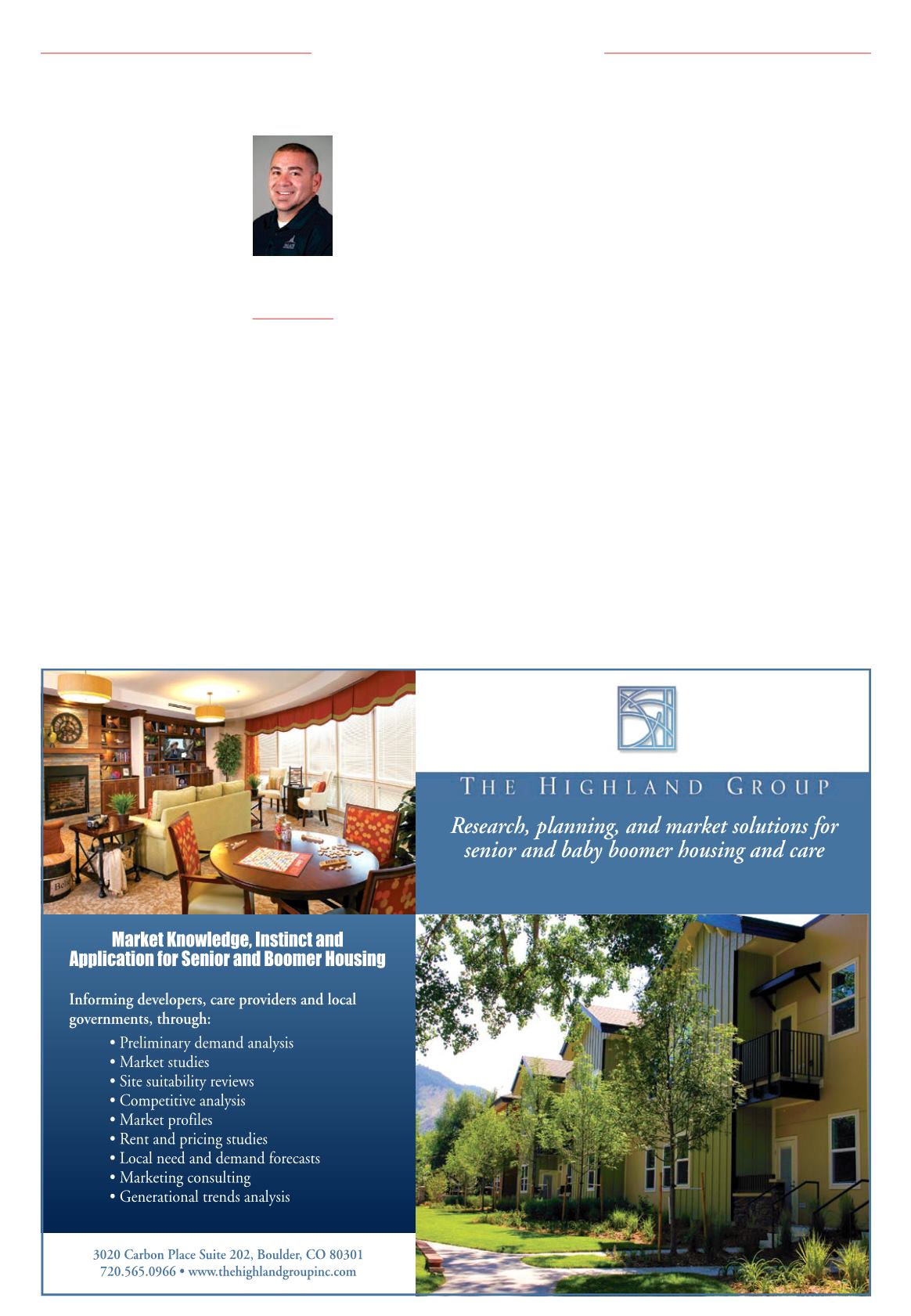
Page 18
— Health Care Properties Quarterly — June 2016
Senior Housing & Care
W
hen a water loss occurs at
a senior-living community,
it can be far more than
a simple inconvenience.
With residents’ complex
health concerns and varying levels
of mobility, engaging in restoration
of the community can seem daunt-
ing. In this situation, it is important
to take immediate action to begin
restoring the community. Hiring a
knowledgeable contractor who is
properly certified with experience
in water loss-related projects can
ensure residents are back in their
homes as quickly and safely as pos-
sible.
n
Identify the type of water loss.
Initially, it is important for a com-
munity to identify the type of water
loss they are experiencing. Per the
IICRC S500 Standards and Reference
Guide for Professional Water Dam-
age Restoration, there are three cat-
egories of water that cause damage
in buildings:
• Category 1 water, referred to
as “clean water,” presents no sig-
nificant risk of causing sickness or
discomfort, but can become pro-
gressively contaminated as it mixes
with soils on or within floor cover-
ings or building assemblies. Water
loss examples include burst water
pipes, failed supply lines on appli-
ances and vertically falling rainwa-
ter.
• Category 2 water, referred to
as “grey water,” begins with some
degree of contamination and could
cause sickness or
discomfort if con-
sumed by humans.
Water loss exam-
ples include aquar-
iums, waterbed
leak, toilet bowl
flow (urine only),
dishwasher or
washing machine
discharge.
• Category 3
water, referred to
as “black water,” is
highly contaminat-
ed and could cause
death or serious illness if consumed
by humans. Water loss examples
include sewage, rising flood water
from rivers/streams and ground
surface water flowing horizontally
into homes.
n
Know when to call a contrac-
tor.
If the damage is a Category 1
water loss, a facility manager usu-
ally can handle the cleanup and
repair without having to bring in a
contractor. This type of damage will
be manageable if there is minimal
water present in a structure or if
the leak or water damage occurs in
an isolated location of the room. If
the water is deemed to be Category
2 or 3, a contractor should be called
immediately. However, a facility
manager should always err on the
side of caution and contact a pro-
fessional if unsure about the type of
water or extensiveness of damage.
A restoration contractor is essen-
tial if the water damage starts
affecting the walls and structure of
a facility. Drying the structure can
be a complex procedure and usu-
ally requires a seasoned restoration
professional. If the structure is not
mitigated properly, it could lead to
mold and microbial growth, which
can set in as early as 72 hours after
a water loss and can result in build-
ing damage, ventilation issues and
air quality concerns.
n
Selecting a contractor.
When
selecting a contractor for the job, a
facility manager should do exten-
sive research on the company’s
qualifications and reputation.
Due to the complexity and sever-
ity of the situation, it is crucial to
see if the company in question
has worked in a similar capacity
and has handled water loss dam-
age. A company with little to no
experience with extensive dam-
age to a community with specific
health concerns most likely will
be unaware as to how to properly
handle the situation. It is equally
important to hire a contractor who
has staff and technicians who are
certified for the type of loss and
equipment that will be needed to
complete the job. Most restoration
contractors will have a specific cer-
tification through the Institute of
Inspection Cleaning and Restoration
Certification. A reputable contractor
will go over the process with com-
munity managers and staff to make
sure they are clear on certain pro-
cedures, as well as how to safely go
about their jobs during restoration.
n
Senior-living facility water loss.
In any type of water intrusion in
a senior-living community, it is
best to relocate the residents to
other rooms immediately. Once a
contractor comes in to restore the
area, drying equipment will need to
run continually until the structure
is completely dried, which could
take from three to four days. The
equipment used during the dry-
ing process kicks up dust and any
other particles affected in that area,
making it uninhabitable during this
time.
Containment is essential to
reduce drying time and isolating
the affected area. Once contained,
treating air quality becomes the
top priority. When contaminants
become airborne and are inhaled,
allergic reactions can shortly fol-
low. Sewage mixed with the flood
water is of special concern due to
an increased possibility of disease.
This can be extremely hazardous
to anyone living in the damaged
area, especially elderly occupants
whose immune systems may not be
able to fight off airborne contami-
nants. A qualified contractor uses
containment and HEPA air scrub-
bing machines on every Category 3
water situation (black water) to con-
trol the air quality and eliminate
cross-contamination of unaffected
areas.
s
Will Denning
Mitigation
director, Palace
Construction,
Denver


